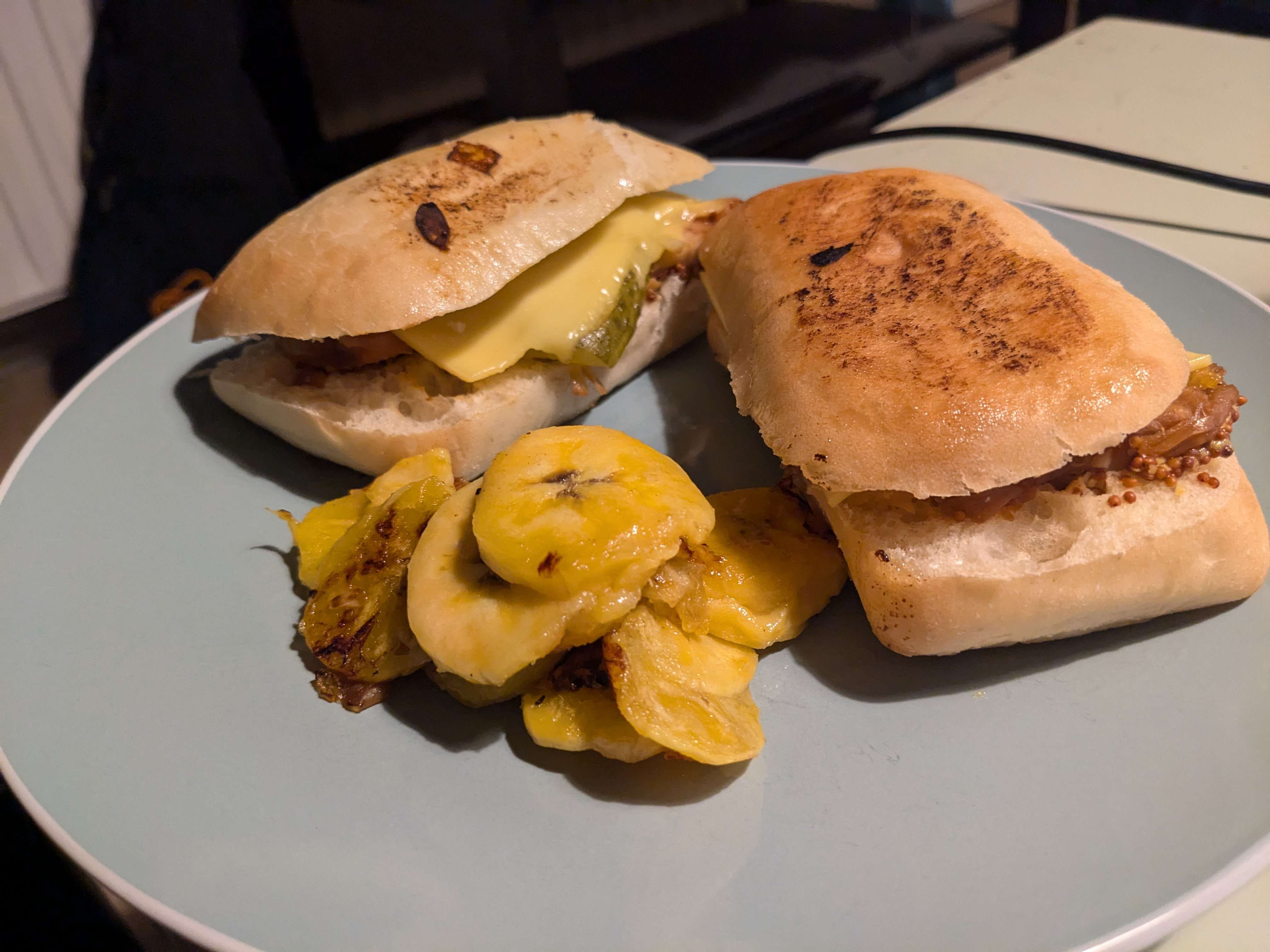
Vegan Cuban Sandwich
Ingredients
2 cans young jackfruit
1 onion, sliced into half moons
2 cloves garlic, minced
1 tbsp lime juice
2 tbsp soy sauce
1 tbsp sugar
2 tsp cumin
2 tsp paprika
1 tsp cayenne pepper
Salt
Pepper
Mustard
Sliced dill pickles
Sliced vegan cheese
Italian rolls
Instructions
- Heat oil in a pan over medium heat. Once heated, add the onion and garlic, cooking until the onion is translucent (4-5 minutes).\
- Add the jackfruit, juices, sauces, and spices, mixing until everything is covered. Cook until the liquid is evaporated (7-10 minutes). \
- Slice the rolls open and slather them with mustard to taste. Add the cooked filling, cheese, and pickles. \
- Once stuffed, place them in the oiled pan, pressing them down to compress the fillings. Cook until the bread is toasty and brown (3-4 minutes).
A Longer, More Detailed Description
Sandwiches are the best food. This is not, and never has been a question. It’s a fact of reality that sandwiches are the best, and all other foods pale in comparison. Maybe it’s the result of sandwiches being food you can eat with your hands, maybe it’s because of the combination of crunchy bread with squishy fillings, who knows. The point is, sandwiches are awesome.
This sandwich especially so.
Start by making your filling. Add onions and garlic to a pan, saute them until that glorious point where they’re delicious, then add your jackfruit, spices, juices, and sauces. Mix them all together until everything is covered, turn up the heat a little, and cook until the liquid has gone off to the great liquid castle in the sky, and your jackfruit is nice and tender.
This is when the sandwich gets fun. Remember that bread you bought? Those fancy rolls which have, up until now, been sitting by the stove, wondering what’s about to happen? Eviscerate them, then stuff their insides, first with mustard, then with fillings, pickles, and cheese, each to taste, though your taste really should be to stuff that bread silly. Once it’s stuffed, return it to the oily pan and fry it. We’re going to take a good sandwich and make it amazing through the liberal application of more heat. Fry it until it’s nice and toasty and brown, then eat it, preferably sloppily, and with melted cheese going everywhere. Buen provecho!
Suggestions and Substitutions
For the bread: This should ideally be made with Cuban bread, but I live in the Netherlands, and we don’t have that here. I used some nice looking rolls I found at my local bakery instead. You’re welcome to use whatever bread you like, as long as it’s joyful bread and not, like, Wonderbread.
For the mustard: Similarly to the above, you should ideally be using that fancy pants mustard that your mother keeps in the back of the fridge for special occasions. I guess you could use the stuff that comes in the yellow squeezy bottle, but do you really want to do that to yourself?
Other toppings: I’ll get into it in the context section, but there are a wide variety of schools of thought on what toppings constitute a Cuban sandwich. I picked the toppings I thought sounded tasty, but these are also made with lettuce, tomato, and mayo (if in Key West), or salami (Tampa), as well as other variations that I am not familiar with, because I am from neither Florida nor Cuba. Feel free to add whatever you like, as long as it brings you joy.
Serving suggestion: Serve it with fried plantains, just because everything is better with fried plantains.
What I changed to make it vegan
This is going to shock you, but a pulled pork, ham, and cheese sandwich is not generally vegan. Instead, I subbed in jackfruit for the pork, vegan cheese for the cheese, and cut the ham entirely. I think I captured the texture, and it is a damn tasty sandwich.
What to listen to while you make this
I had a lovely time bopping around my kitchen, listening to Cubanito 20.02. I recommend their Soy Cubanito album, with Pideme being a fun introduction to their sound.
A brief context for this dish
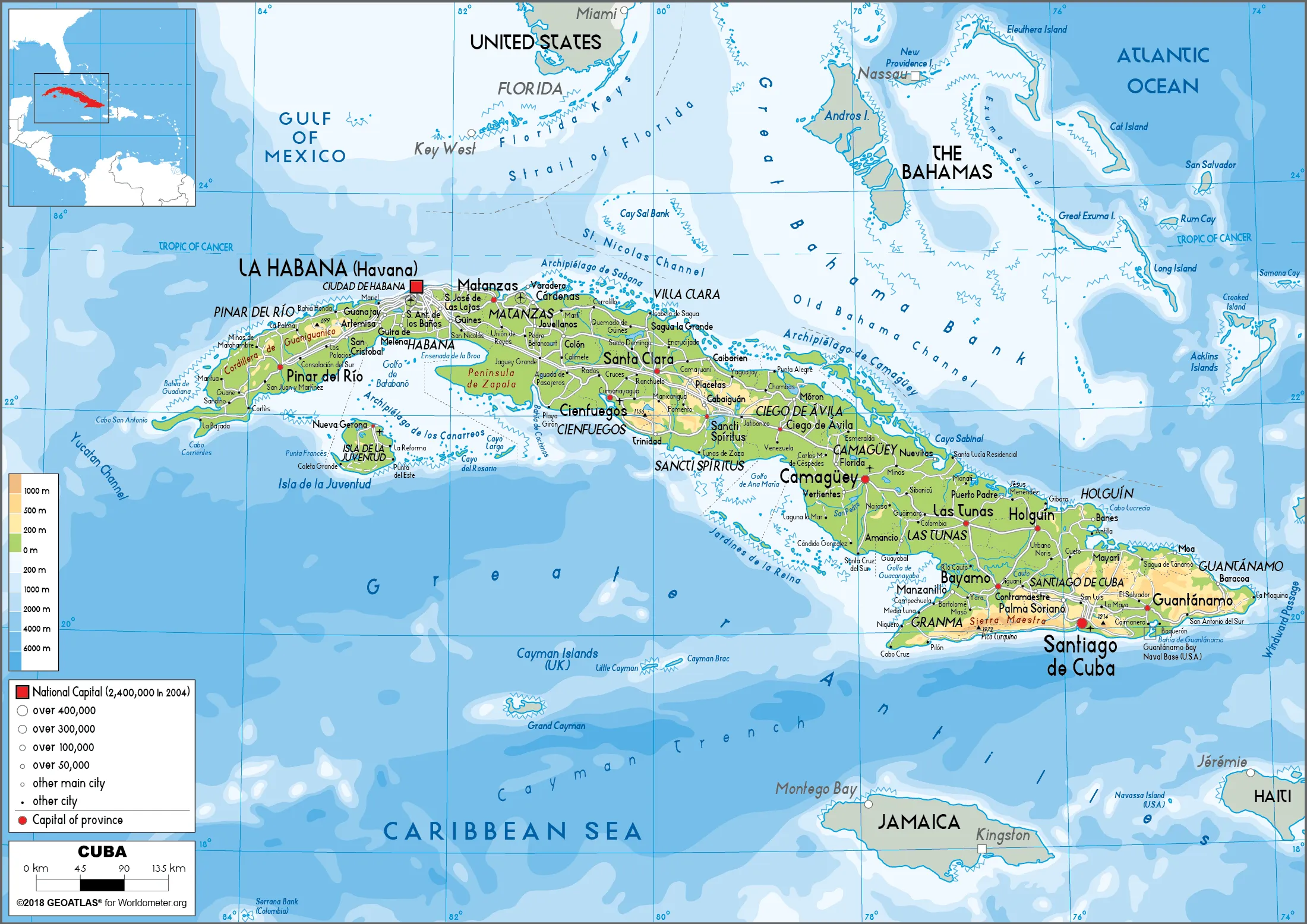
I’ll be honest - the Cuban sandwich is perhaps less indicative of Cuban national cuisine than some of the dishes I’ve chosen for their countries, but I still stand by my choice to make it for Cuba. The story of the sandwich is, after all, a reflection of the story of Cuba itself and the movement of peoples and ideas between Cuba and the mainland.
Before diving into the Cuban sandwich, much of the research and information in this post comes from much better and more experienced researchers than me and their book, “The Cuban Sandwich: A History in Layers.” I highly recommend checking it out for a more in-depth exploration of the cultural dynamics, migration patterns, and human realities that have defined the Cuban sandwich. Today’s pictures are sourced from here.
Like many of its Caribbean neighbours, Cuba’s culinary history is a mishmash of a variety of influences, ranging from indigenous ingredients to rice brought from Asia to European culinary traditions to African culinary traditions. Cuba’s early history is defined by colonialism, with sugar plantations making up a huge part of its economy, and the port of Havana dominating the early modern Caribbean. By the 19th century, however, dissatisfaction with Spanish authorities led to an upswell in Cuban political nationalism and the beginning of the migration of Cubans from Cuba to Florida.
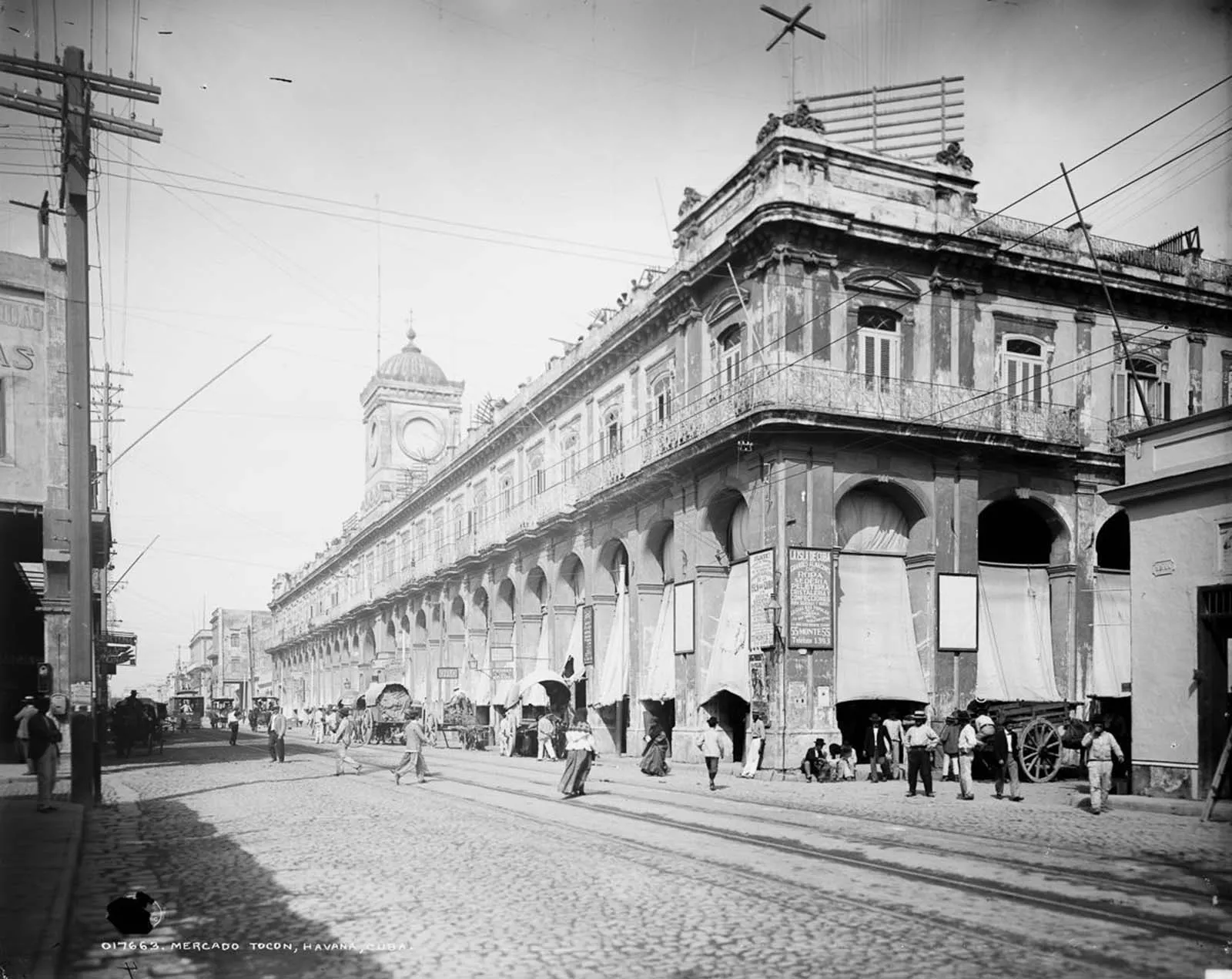 Image of Havana's Mercado Tocon, 1904
Image of Havana's Mercado Tocon, 1904
When we think of the Cuban sandwich, it is almost universally associated with the Cuban communities in south Florida rather than with the island of Cuba itself. There is evidence that the sandwich was born in the 1860s in Cuban sugar mills and rum distilleries and - like a great many other foods - then travelled with its inventors to new lands. However, ascribing the Cuban sandwich to any one place misses the nuance of what it represents.
Throughout the late 19th and early 20th centuries, travel between Cuba and the United States was more or less free-flowing, to the point where Cuban authors complained about the sheer number of “yanquis” invading Havana’s many shops and cafes. Cafes and ice cream parlours advertised specifically to Americans, altering traditional Cuban dishes to better suit Americans’ more tepid palates. At the same time, Cubans living in Florida recreated the dishes of home, carrying recipes back and forth as they travelled from Havana to Tampa and back again. Among these was the recipe for Cuban bread, long, crusty sticks of bread, renowned on both sides of the sea for being the world’s best bread.
It’s in this melting pot that the Cuban sandwich was born, somewhere in the grand mixture between Cuba and Florida, and in the combination of two cultures and groups of people mingling alongside each other.
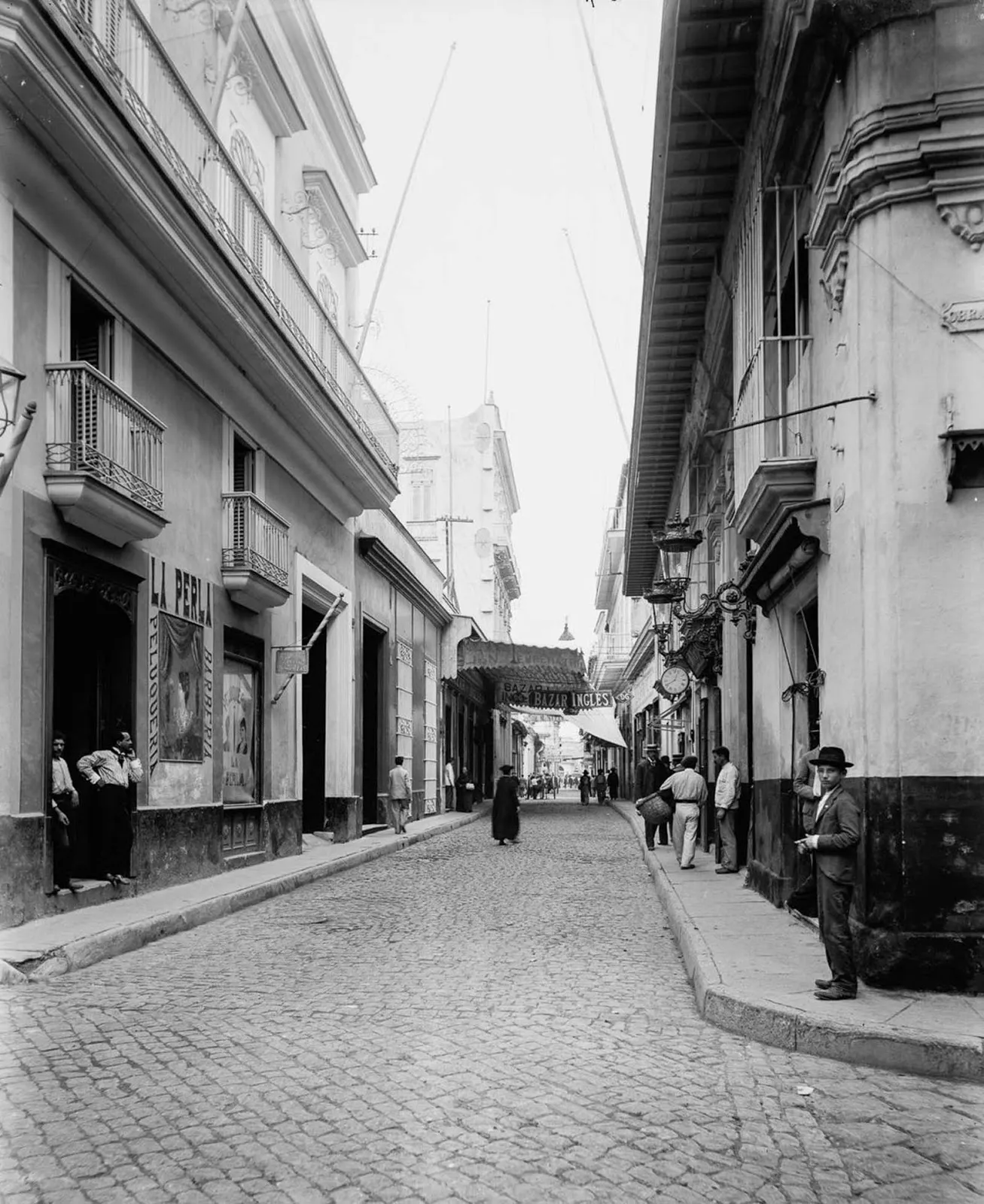 Obrapia Street, Havana, 1900. Note the "English Bazaar" in the background.
Obrapia Street, Havana, 1900. Note the "English Bazaar" in the background.
The Cuban sandwich is a product of that blending of American with Cuban, as well as the unique time period in which this melding was taking place. Though sandwich-like things have existed for centuries, the sandwich as an institution was a recent invention, gaining in popularity as it moved from a poverty necessity to a cultural icon. The ability to bake softer bread and to slice it was revolutionary in popularising the sandwich. For Cubans, the creation of the sandwich was a combined influx from both Europe and the United States, brought in and combined with local ingredients to create something new and exciting. The first references to the Cuban sandwich as we understand it are from Tampa in the early 1900s, though it appeared simultaneously throughout Havana’s cafes as well. Each journey back and forth from Havana to Florida and vice versa continued to transmit the sandwich, making a more and more indelible part of the Cuban identity.
And then, in 1960, the United States imposed an embargo on Cuba following Fidel Castro’s 1959 Communist revolution. In 1962, following the Cuban missile crisis, the embargo became total. Americans are banned from travelling to or doing business in Cuba in what has become one of the world’s longest and most comprehensive trade embargoes. The long history of travel back and forth between Cuba and Florida was abruptly ended, severing the blended community.
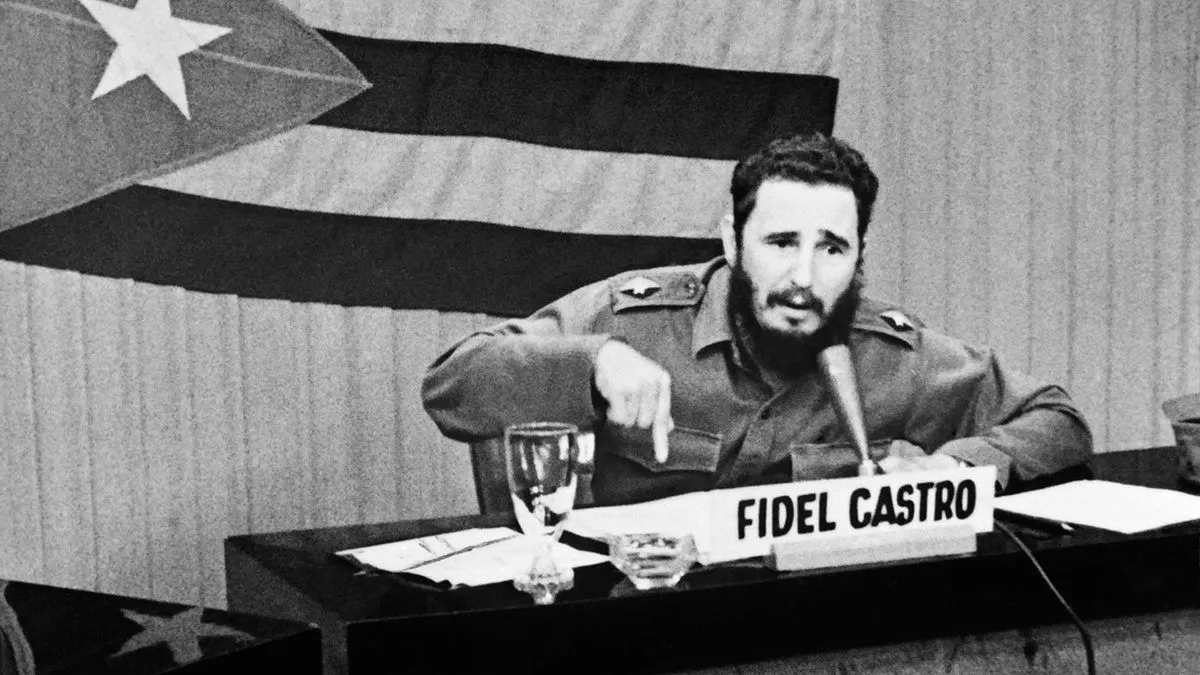 Fidel Castro in 1960
Fidel Castro in 1960
The Cuban sandwich is the symbol of a community, but also the symbol of a past that is now lost. It sprang out of the free flow of people and ideas, and became an institution in and of itself. It continues to be a symbol of a community in exile, as well as the island now isolated from its past. It’s a reminder of a world that once was, but also potentially a promise of what could once again be.